IoT Data Collection for Climate-Specific Gardening
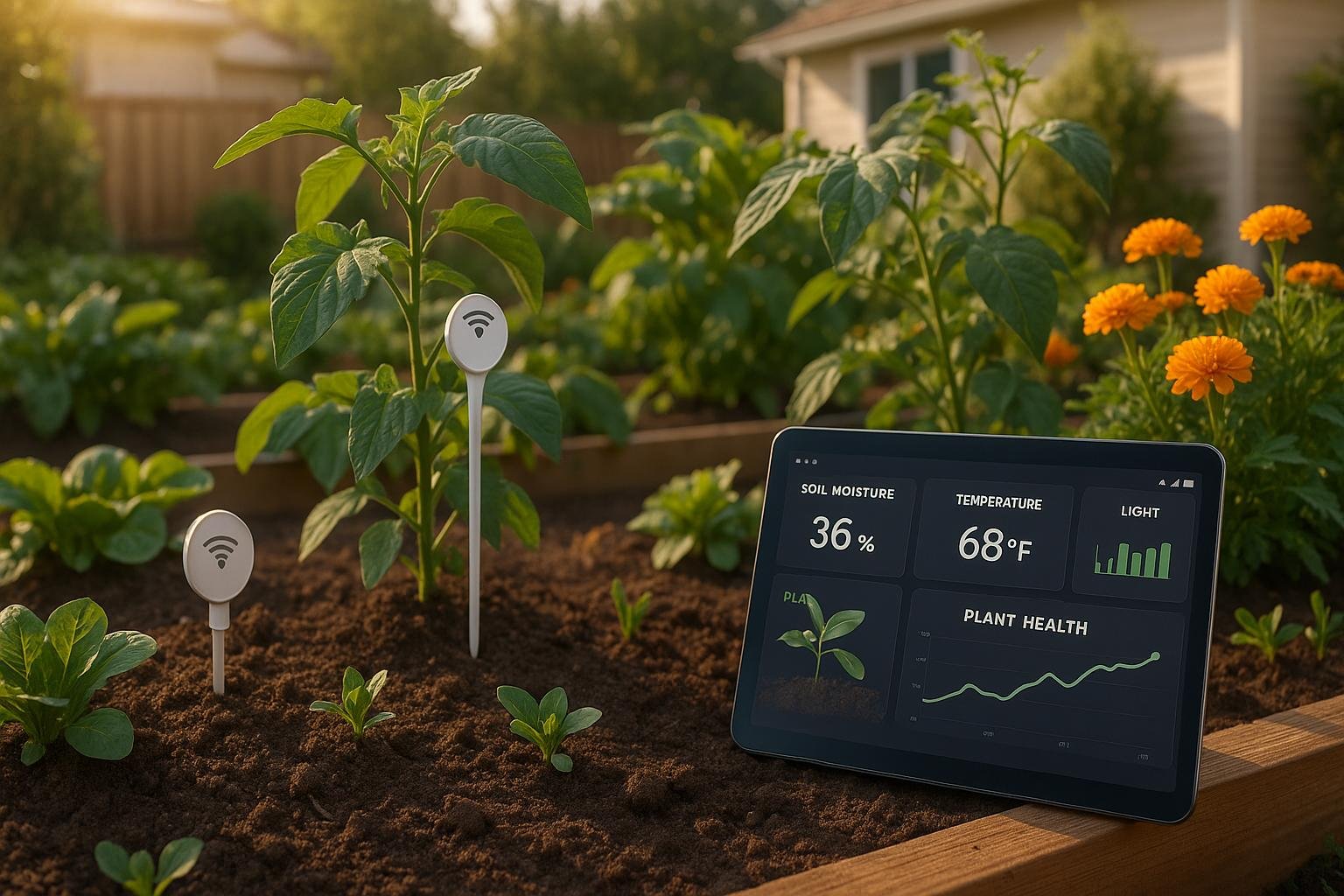
Smart gardening is here, and IoT is leading the way. By using connected sensors, weather stations, and AI-driven platforms, gardeners can now monitor soil moisture, temperature, light, and humidity with precision. This data-driven approach helps optimize irrigation, predict plant diseases, and improve crop health - all while saving resources like water and fertilizer.
Key Takeaways:
- IoT Sensors: Track soil moisture, temperature, humidity, and light for better garden care.
- AI Integration: Analyze data to predict diseases and recommend personalized gardening actions.
- Efficiency Gains: Save up to 40% on water and reduce fertilizer use by up to 40%.
- Popular Devices: Soil moisture sensors (e.g., Ambient Weather WH31SM for $42.99) and weather stations improve decision-making.
- Challenges: High initial costs, connectivity issues, and data management complexity.
IoT and AI are transforming gardening into a precise, resource-saving practice, making it easier to maintain healthier gardens across diverse climates.
Water Your Garden with IoT - Soil Moisture Sensors

Key IoT Devices for Climate Data Collection
To successfully integrate IoT technology into gardening, it all starts with choosing the right sensors. These devices gather crucial climate data, providing a detailed view of your garden's environment. By doing so, they allow for smarter decisions and automated adjustments to changing conditions. These sensors lay the groundwork for using AI to forecast plant diseases effectively.
IoT Sensors for Gardening
Soil moisture sensors are a must-have for any IoT gardening setup. These sensors measure how much water is present in the soil, typically expressed as volumetric water content (m³/m³), which can also be shown as a percentage. Take the Ambient Weather WH31SM Soil Moisture Sensor, for instance. At $42.99, it updates data every 72 seconds and has an average rating of 4 out of 5 stars from 77 reviews [5]. For larger-scale applications, the Onset 10HS Soil Moisture Smart Sensor, priced at $209.00, offers more extensive soil monitoring capabilities, also using volumetric water content for its readings [6].
Temperature and humidity sensors are key to tracking atmospheric conditions that directly impact plant health. NTC thermistors are a popular choice for gardeners due to their affordability and ease of installation compared to RTD sensors [2]. These sensors also play a role in identifying conditions that may lead to pest problems or disease outbreaks by monitoring temperature and humidity ranges that promote such issues.
Light sensors measure the sunlight your garden receives, both in intensity and duration, which is critical for photosynthesis and plant growth. Pairing these with air quality sensors provides a fuller picture of environmental conditions, helping you optimize growth and spot potential stressors.
Electrochemical sensors are invaluable for monitoring soil pH and nutrient levels. By using these sensors, you can determine the best times to fertilize and maintain the ideal conditions for plant growth [4].
IoT Weather Stations and Soil Probes
Modern IoT weather stations go beyond basic readings. They collect detailed environmental data like temperature, humidity, wind speed, wind direction, precipitation, and air pressure. This data is then sent wirelessly to cloud servers for analysis, enabling automated responses to changing weather conditions [3][4]. The market for IoT-based weather stations is projected to grow by over $29.687 million by 2026, with an annual growth rate of 7.09% [4].
Soil probes delve deeper - literally - by measuring moisture, temperature, and electrical conductivity at various depths. For example, the NCD Long Range IoT Wireless Soil Moisture Sensor, priced at $252.95, offers a range of up to 2 miles [8]. For more professional needs, the HOBOnet Multi-Depth Soil Moisture Sensor, starting at $839.00, provides a comprehensive soil profile [10].
The benefits of these tools are clear. For instance, WiseConn's DropControl system uses interconnected IoT sensors to monitor soil moisture and weather, helping farmers cut water usage by up to 30% and avoid issues like overwatering or underwatering [4].
"EarthScout helped us reduce our irrigation costs from $75 per acre down to $50, which saves us about $3,000 for every 120-acre field."
– Grant Anderson, Corn & Soybean Grower, Anderson Farms, MN [9]
US Measurement Standards Compatibility
For American gardeners, having IoT devices that align with US measurement standards is crucial. Most devices designed for this market provide data in familiar units like Fahrenheit for temperature and inches for rainfall, making it easy to act on the information.
For instance, soil moisture readings given in volumetric water content (m³/m³) are often converted to percentages for quick understanding. A reading of 0.35 m³/m³ translates to 35% moisture content. Similarly, temperature sensors often convert Celsius to Fahrenheit (so 25°C becomes 77°F), and rainfall sensors switch from millimeters to inches (10 mm becomes roughly 0.39 inches).
The Davis Instruments Soil Moisture Sensor, priced at $95.00 and boasting a perfect 5-star rating, is an excellent example of this compatibility [7]. In 2024, Bert Bouwman, a grower from Brooklyn Park, Minnesota, shared his experience with an EarthScout soil moisture sensor. By using the sensor, he cut his irrigation costs in half during the first year, saving 50%. Encouraged by the success, he added three more sensors to monitor his greenhouse and fruit fields [9].
When choosing IoT devices, make sure they provide data in units that are easy to understand and act on. This ensures you can quickly make informed decisions about irrigation, fertilization, and adjusting your garden's microclimate. With this tailored data, you're ready to take the next step: integrating IoT data with AI to predict and prevent plant diseases.
Connecting IoT Data with AI for Disease Forecasting
When IoT sensors start gathering environmental data, the real magic happens when that data is processed by AI systems. This seamless connection transforms raw information into actionable insights, helping predict and even prevent disease outbreaks. With continuous data analysis, your garden becomes a smart, self-regulating ecosystem.
How IoT and AI Systems Work Together
IoT devices constantly monitor key environmental factors like humidity, temperature, and soil moisture, as well as more advanced indicators such as biochemical and genetic markers [12]. This data is transmitted wirelessly to cloud-based AI systems, where it’s cleaned - removing outliers, filling gaps, and standardizing measurements - before analysis [15].
Modern AI algorithms process this data in real time, creating a feedback loop that improves performance as more data is collected. Over time, the system adapts to the specific conditions of your garden. For example, AI models trained on over 54,306 images from 14 crop species and 26 diseases have reached accuracy rates as high as 99.35% in identifying crop diseases [13]. This efficient data flow ensures timely and accurate disease predictions, directly benefiting your garden.
Why Predictive Disease Modeling Matters
AI-powered apps can identify plant diseases with an impressive 98% accuracy, offering instant diagnostics right on your smartphone [12]. Predictive analytics take this a step further by combining historical weather data with real-time garden conditions to forecast potential disease outbreaks with up to 85% accuracy [12]. Research on rice blast disease, for instance, highlights precipitation as the most significant factor (48%), followed by minimum temperature (31%), maximum temperature (17%), and humidity (3%) [11].
These predictions translate into practical advantages for garden management. Smart irrigation systems, for instance, can cut leaf wetness duration by up to 40%, significantly reducing the risk of fungal infections [12]. Considering that pests and diseases are responsible for 20%–40% of global food production losses annually [14], timely interventions supported by AI can save both resources and crops. Advanced management tools can lower disease incidence by up to 60%, making them a valuable asset for gardeners [12].
How US Gardeners Can Benefit
For gardeners in the United States, AI-driven tools align perfectly with goals of conserving resources and promoting sustainability across diverse climates. Handheld DNA sequencers, for example, allow home gardeners to identify pathogens with 99% accuracy in just 30 minutes [12]. When paired with weather prediction technology, these tools can assess disease risks by monitoring critical factors and using local forecasts to predict issues days or even weeks in advance [12]. Additionally, innovations like drone surveillance and blockchain systems are enhancing regional disease monitoring capabilities [12].
Studies consistently show that effective disease management depends on timely, reliable data [11]. This principle holds true for home gardeners aiming to maximize yields while minimizing waste and environmental impact. With these tools, American gardeners can take a proactive approach to protecting their plants and achieving healthier, more productive gardens.
🚀 Ready to Reinvent Your Garden?
Join thousands of homeowners who have transformed their gardens using our AI design tool. Upload one photo to explore endless possibilities.
Get your AI garden designs →Practical Uses of IoT in Gardening
The Internet of Things (IoT) is changing the way people approach gardening by enabling smarter, real-time plant care. These technologies improve resource management, making gardens more efficient and productive across the diverse climates of the United States. From automated watering systems to precise environmental controls, IoT is taking gardening to the next level.
Automated Irrigation and Fertilization
One of the most impactful IoT applications in gardening is smart irrigation. These systems use soil moisture sensors to figure out exactly when plants need water, taking the guesswork out of watering schedules. This real-time approach prevents overwatering or under-watering, which can stress plants and waste resources [16].
A 2022 Penn State University study highlighted the benefits of IoT irrigation systems for fresh-market tomatoes. Using solar-powered sensors connected via a low-power wireless network (LoRaWAN), the system improved water efficiency by 22% to 28% and increased marketable fruit yields by 15% to 22% [18]. Even smaller setups, like Arduino-based systems, showed impressive results, saving 9.1 gallons of water and 4 fluid ounces of fertilizer - reductions of 61.3% and 53.3%, respectively [18]. These systems not only conserve resources but also help prevent over-fertilization, which can harm plants and contaminate groundwater [17].
For U.S. gardeners interested in adopting IoT solutions, essential components include soil moisture sensors, weather stations to monitor temperature, humidity, and rainfall, and nutrient management systems that track soil chemistry to automate fertilizer application [19].
Microclimate Adjustments for Better Growth
Beyond managing water and fertilizer, IoT technology helps create the ideal microclimate for plants. Sensors continuously monitor factors like temperature, humidity, light, and soil moisture to ensure optimal growing conditions [1]. If humidity levels rise to the point where fungal growth becomes a concern, ventilation systems can automatically kick in to reduce moisture [1].
This level of control is particularly useful in greenhouses and high tunnels, where conditions can be fine-tuned for specific crops. For instance, a study in Kerala, India, demonstrated how IoT could monitor and adjust temperature, humidity, and soil moisture in a fruit nursery. By analyzing evapotranspiration rates in real time, the system optimized water delivery, ensuring plants received just the right amount [20]. Compared to traditional programmable logic controllers (PLCs), IoT systems offer better data sharing and scalability, making them a more versatile solution [1].
Resource Efficiency and Environmental Impact
IoT-enabled gardening doesn’t just benefit individual gardens - it also supports broader conservation efforts across the United States. Traditional gardening methods often waste about 30% of water and 50% of fertilizer [21]. In contrast, farms using IoT technology have seen an average yield increase of 15% while reducing water usage by 20% [21]. Precision irrigation systems can cut water consumption by up to 30%, and nutrient sensors can lower fertilizer use by as much as 40% [21].
These advancements lead to significant cost savings and a smaller environmental footprint. Less fertilizer runoff reduces the risk of groundwater contamination, and smarter water use helps conserve this critical resource, especially in drought-prone areas. Many IoT platforms also incorporate AI and machine learning to analyze sensor data, continuously refining irrigation and fertilization schedules. This creates a feedback loop that supports healthier plant growth while minimizing waste [21]. Combined with AI-driven disease forecasting, these tools ensure plants thrive under optimal conditions.
sbb-itb-4d6a8dd
Benefits and Challenges of IoT-Enabled Gardening
When it comes to using IoT systems in gardening, there’s a lot to consider. These technologies bring exciting opportunities for precision and efficiency, but they also come with hurdles. Let’s dive into what makes IoT-enabled gardening both promising and challenging, so you can decide if it’s the right fit for your needs.
Key Benefits of IoT-Based Systems
IoT systems are game-changers for resource management. With tools like smart sensors and controllers, you can fine-tune the use of water, fertilizers, and pesticides. This not only cuts costs but also improves yields [23]. For example, IoT sensors continuously monitor key factors like soil moisture, air temperature, humidity, and rainfall. Real-time updates allow you to tweak your gardening strategies right when it matters most [23]. Plus, these sensors can detect pests and diseases early by keeping tabs on environmental conditions [23].
The productivity boost is impressive. IoT, paired with AI-driven precision agriculture, can increase crop yields by as much as 30% while slashing water consumption by 20% to 50% [26]. On top of that, precise application of inputs like fertilizers minimizes chemical runoff, preserves soil health, and supports biodiversity, all while reducing your garden’s environmental footprint [22].
Common Challenges and Solutions
While the benefits are clear, IoT-enabled gardening isn’t without its challenges. Here are some common hurdles and ways to address them:
- High upfront costs: Sensors, controllers, and connectivity can be expensive. However, government subsidies and grants may help cover these initial investments [25].
- Connectivity issues: Poor internet access in rural or remote areas can disrupt IoT systems. Low-Power Wide-Area Networks (LPWAN) like LoRaWAN or Sigfox, or even satellite connectivity, can provide reliable alternatives [25].
- Data security risks: Devices often transmit data that isn’t encrypted, making them vulnerable to breaches. Using strong encryption and secure platforms like AWS IoT Core or Microsoft Azure IoT Hub can mitigate these risks [24] [25].
- Technical complexity: Not everyone is tech-savvy, and the learning curve can be steep. Tailored training programs and managed services for installation and maintenance can make the technology more approachable [25].
- Data management challenges: IoT systems generate massive amounts of data, which can be overwhelming. Dedicated platforms designed for IoT data can simplify analysis and provide actionable insights [25].
- Interoperability issues: Sometimes, different IoT devices don’t work well together. Choosing devices that use open protocols like MQTT or CoAP can help ensure seamless integration [25].
By addressing these challenges, gardeners can make the most of IoT technology without getting bogged down by its complexities.
Benefits vs. Challenges Comparison
Here’s a quick breakdown of how the benefits and challenges of IoT-enabled gardening stack up:
| Aspect | Benefits | Challenges |
|---|---|---|
| Resource Management | 20–50% water savings; precise input use | High initial setup costs |
| Crop Health | Early pest and disease detection; 30% yield boost | Requires technical know-how |
| Data Insights | Real-time monitoring; weather-based adjustments | Security risks and complex data analysis |
| Environmental Impact | Reduced chemical runoff; sustainable practices | Connectivity issues in remote areas |
| Long-term Value | Cost savings through efficiency | Ongoing maintenance and upgrade expenses |
| System Integration | Automated and informed interventions | Compatibility issues among devices |
The numbers back up the growing interest in IoT for agriculture. In 2022, the agriculture IoT market was valued at $13.61 billion, and it’s expected to hit $33.57 billion by 2032 [27]. As technology evolves and costs become more manageable, IoT gardening is becoming an increasingly viable option for both hobbyists and small-scale growers across the U.S.
Conclusion
IoT data collection is transforming climate-specific gardening by replacing uncertainty with precision. By monitoring environmental conditions in real-time, predicting disease outbreaks, and optimizing resource use, it’s paving the way for smarter and more sustainable gardening practices.
Key Takeaways
Integrating IoT sensors with AI-powered systems is reshaping modern gardening. Sensors track soil moisture, temperature, humidity, and weather patterns, giving gardeners the tools to make informed decisions. This approach not only boosts productivity but also cuts water usage by up to 40% - a critical improvement considering that pests and diseases cause global crop losses ranging from 20% to 40% [28] [30].
Studies highlight the reliability of disease forecasting models in predicting outbreaks and supporting sustainable agriculture [11]. Efficient resource management through IoT is vital, especially since agriculture accounts for 70% of all freshwater withdrawals, while freshwater itself represents just 0.55% of the Earth’s water supply [29].
The agriculture IoT market is also gaining momentum, projected to hit $33.57 billion by 2032 with an annual growth rate of 9.50% [27]. This trend underscores the growing acknowledgment that IoT-enabled gardening is essential for climate resilience and sustainable food production.
AIGardenPlanner's Role in Smart Gardening
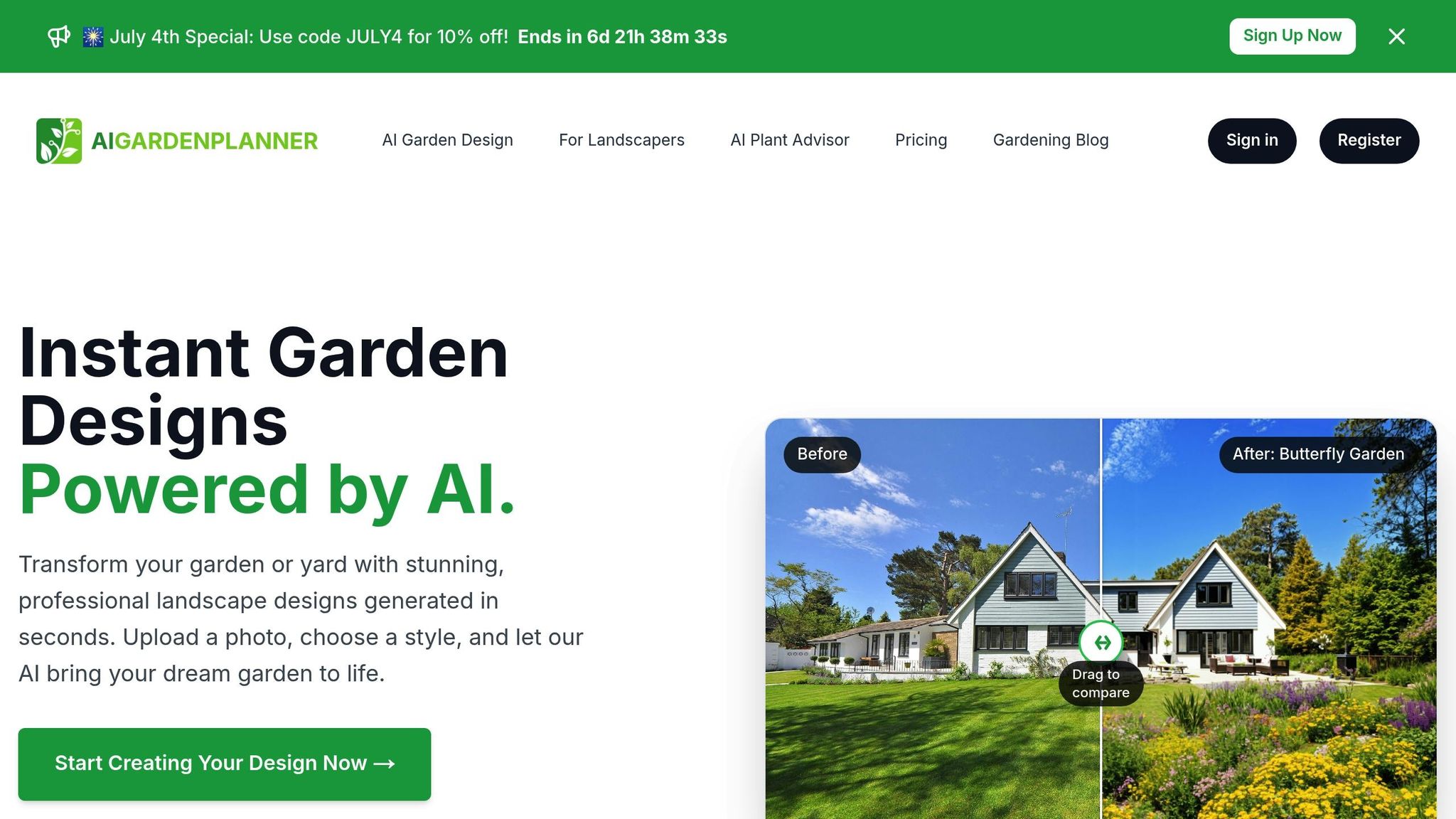
AIGardenPlanner takes these advancements a step further, bridging the gap between complex IoT data and practical gardening solutions. By harnessing AI, the platform translates environmental data into actionable garden designs tailored to local conditions. With support for over 5,000 plant varieties and the ability to create detailed layouts for up to 100 garden zones in a single session [31], it transforms IoT insights into user-friendly recommendations for gardeners across the US.
This blend of climate-specific planting advice and real-time monitoring offers a holistic approach to garden management. As horticulturist Ethan Bloomfield shares, "Having an AI design my garden layout, suggest suitable plants, and provide customized care instructions is absolutely game-changing!" [31]. By combining IoT data collection with AI-driven analysis, this approach points to a future where technology and human expertise work hand in hand to create resilient, thriving gardens tailored to America’s diverse climate zones.
FAQs
How do IoT sensors and AI help detect and prevent plant diseases in gardens?
IoT sensors and AI team up to keep gardens thriving by gathering real-time data on key factors like temperature, humidity, soil moisture, and light levels. Some sensors even go a step further by capturing images to help spot potential problems.
With this data in hand, AI steps in to analyze and detect early signs of plant stress or disease - often before you’d notice anything wrong. By spotting patterns and predicting risks, this technology empowers gardeners to act quickly, minimizing plant loss and boosting the overall health of their gardens.
For a more tailored gardening experience, check out tools like AIGardenPlanner, which offer personalized advice based on your garden’s specific location and climate.
How much does it cost to set up an IoT-enabled garden, and how can I save money on it?
🎨 Visualize Your Dream Garden Today!
Transform any outdoor space into a professional landscape design in minutes. Just upload a photo, choose your style, and let our AI do the rest.
Start your garden transformation now →How Much Does It Cost to Set Up an IoT-Enabled Garden?
The price tag for creating an IoT-enabled garden can range from just a few hundred dollars for a basic setup to over $50,000 if you're going for a more advanced system with premium hardware and software. The final cost depends on a variety of factors, including the size of your garden, the system's complexity, and the specific sensors or devices you decide to include.
If you're looking to keep costs down, there are some smart strategies to consider. For instance, DIY options using affordable hardware like Raspberry Pi or Arduino can be a great way to build a functional system without breaking the bank. Another approach is to implement the system in phases, allowing you to spread the expenses over time. Additionally, buying components in bulk or opting for scalable, cost-effective designs can help you achieve your goals without overspending.
How does IoT technology improve water and fertilizer management in gardens with varying climate conditions?
IoT technology is transforming how we manage water and fertilizer in gardens by delivering real-time insights into critical factors like soil moisture, temperature, humidity, and even plant health. With this data, gardeners can fine-tune their care routines to match the specific needs of their garden's environment, ensuring better results while using resources wisely.
IoT sensors and systems also make it possible to automate tasks like irrigation and fertilization. This not only cuts down on waste but also improves efficiency. In fact, research shows that these technologies can save up to 50% of water while enhancing plant health and increasing yields. This can be a game-changer, particularly for gardens located in regions with variable or challenging climate conditions.
Related posts
Related Articles
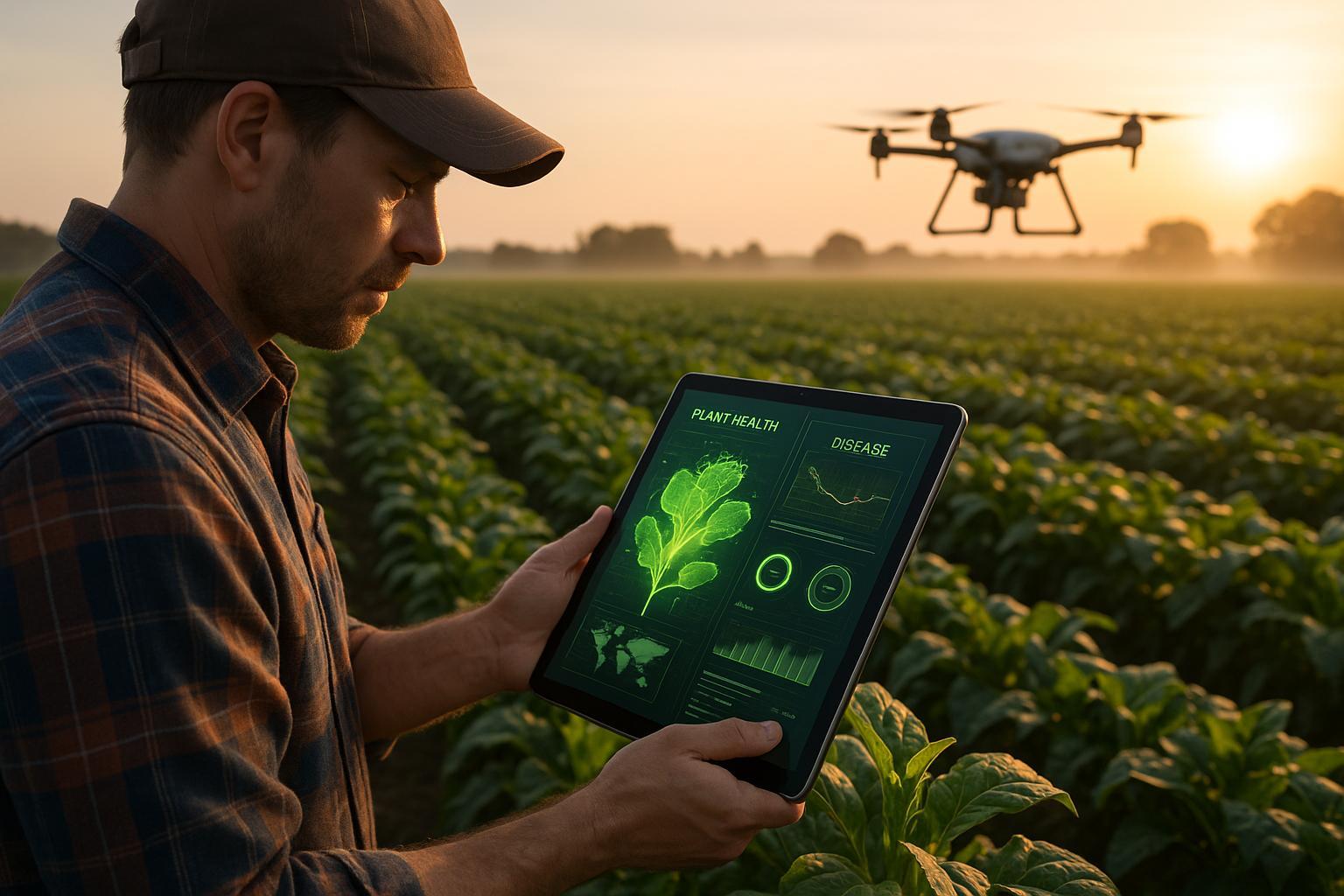
AI Tools for Predicting Plant Disease Outbreaks
AI tools are revolutionizing crop protection by predicting plant diseases accurately and helping farmers increase yields while minimizing pesticide use.
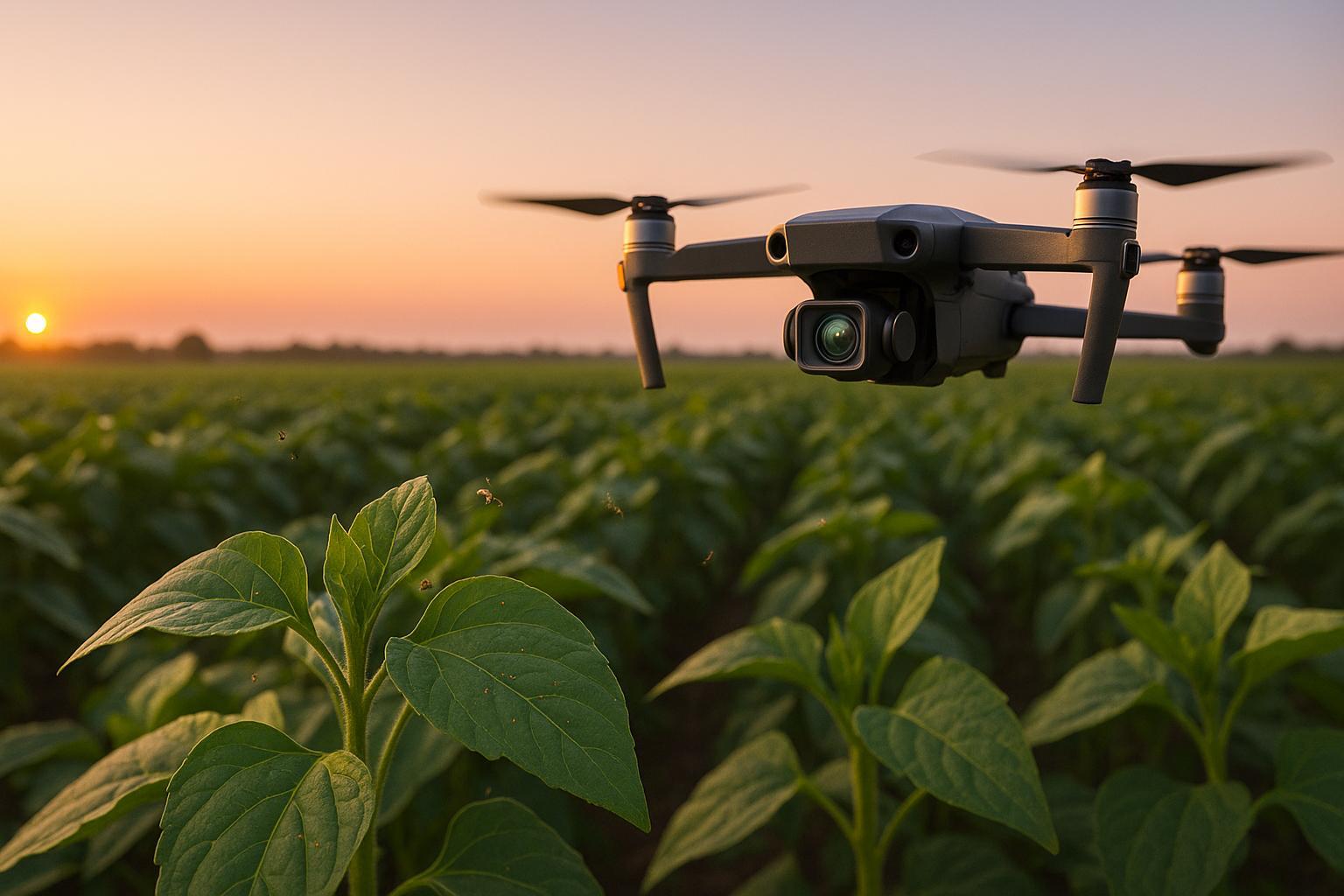
AI Pest Detection in Video Feeds
Learn how AI pest detection systems enhance crop management through real-time monitoring, reduced pesticide use, and actionable insights for farmers.
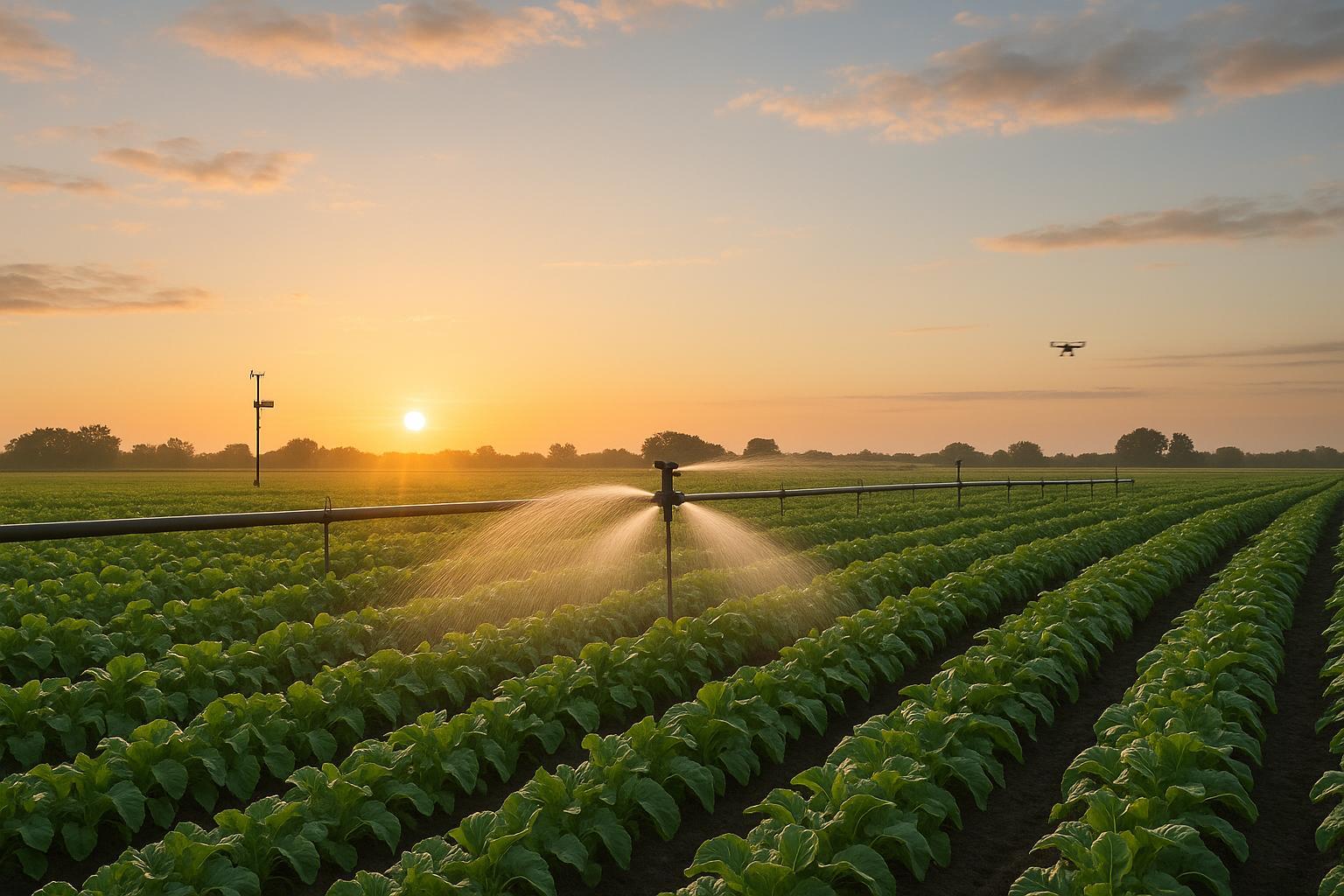
How AI Predicts Weather for Smarter Irrigation
Explore how AI-driven weather predictions optimize irrigation systems, enhancing water efficiency, crop yields, and cost savings for farmers.
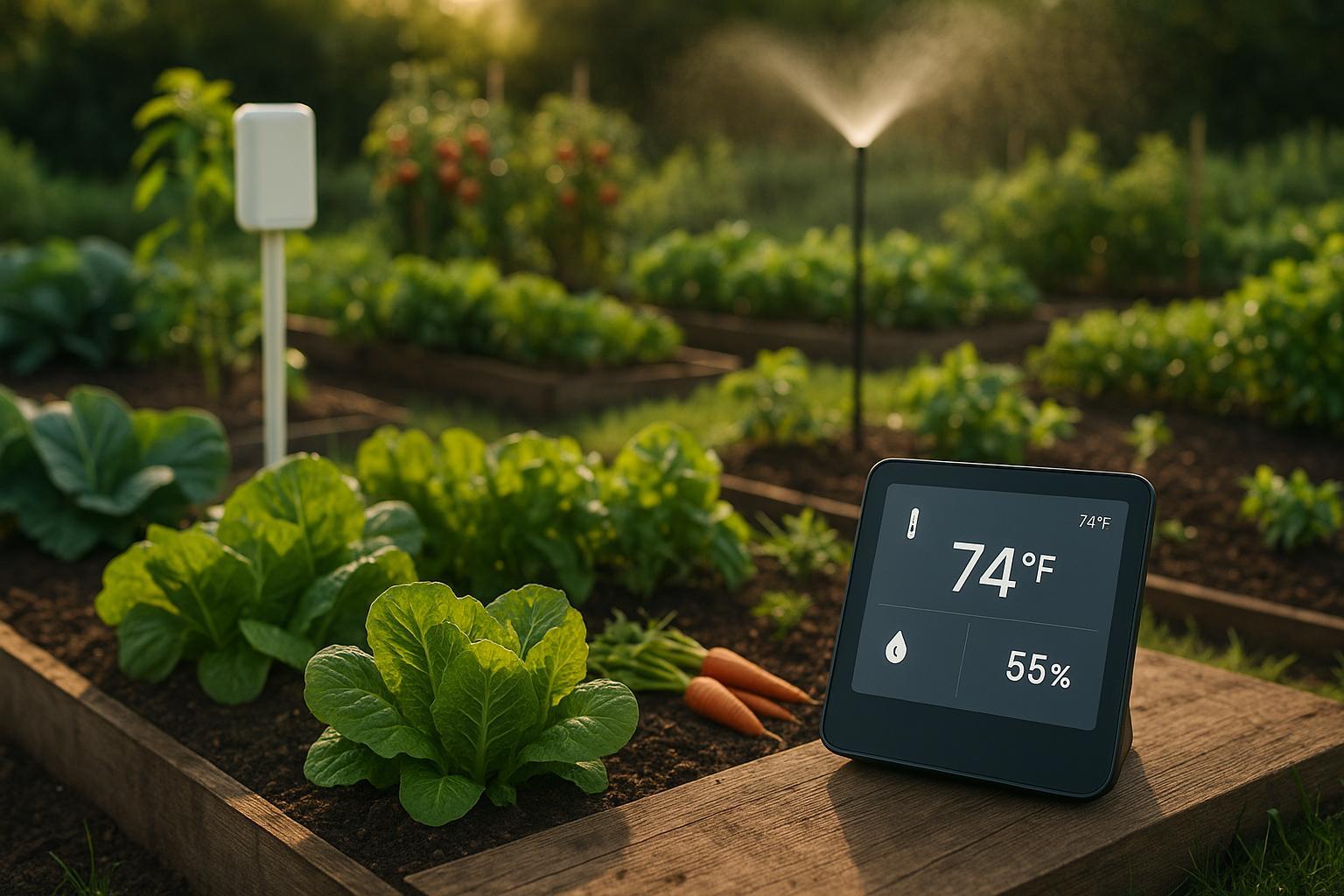
How Remote Climate Control Boosts Garden Productivity
Explore how remote climate control systems enhance garden productivity through automation, yielding higher returns and resource efficiency.
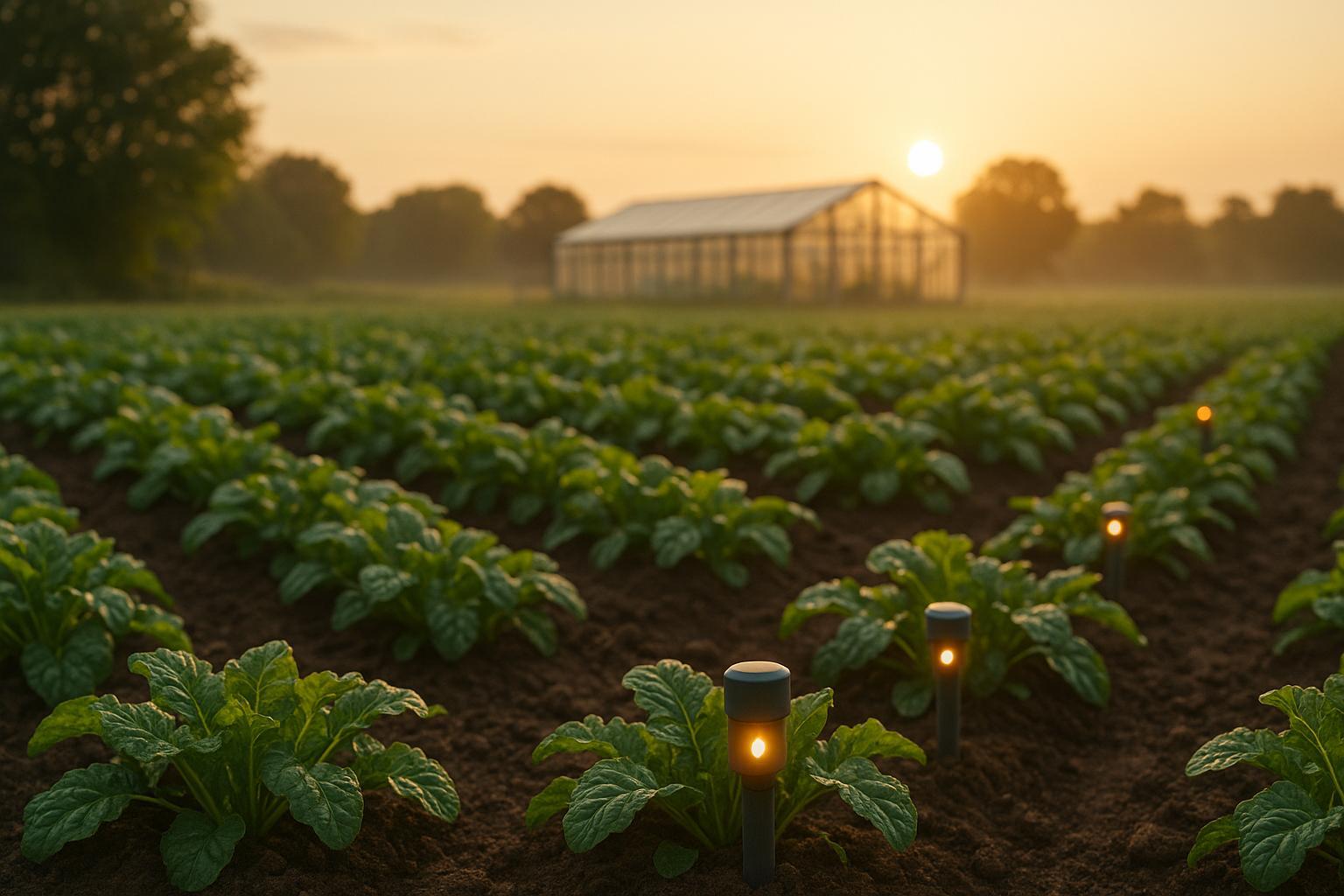
How Sensor Networks Detect Plant Diseases Early
Learn how sensor networks enable early detection of plant diseases, improving crop health and reducing losses through real-time monitoring and AI analysis.
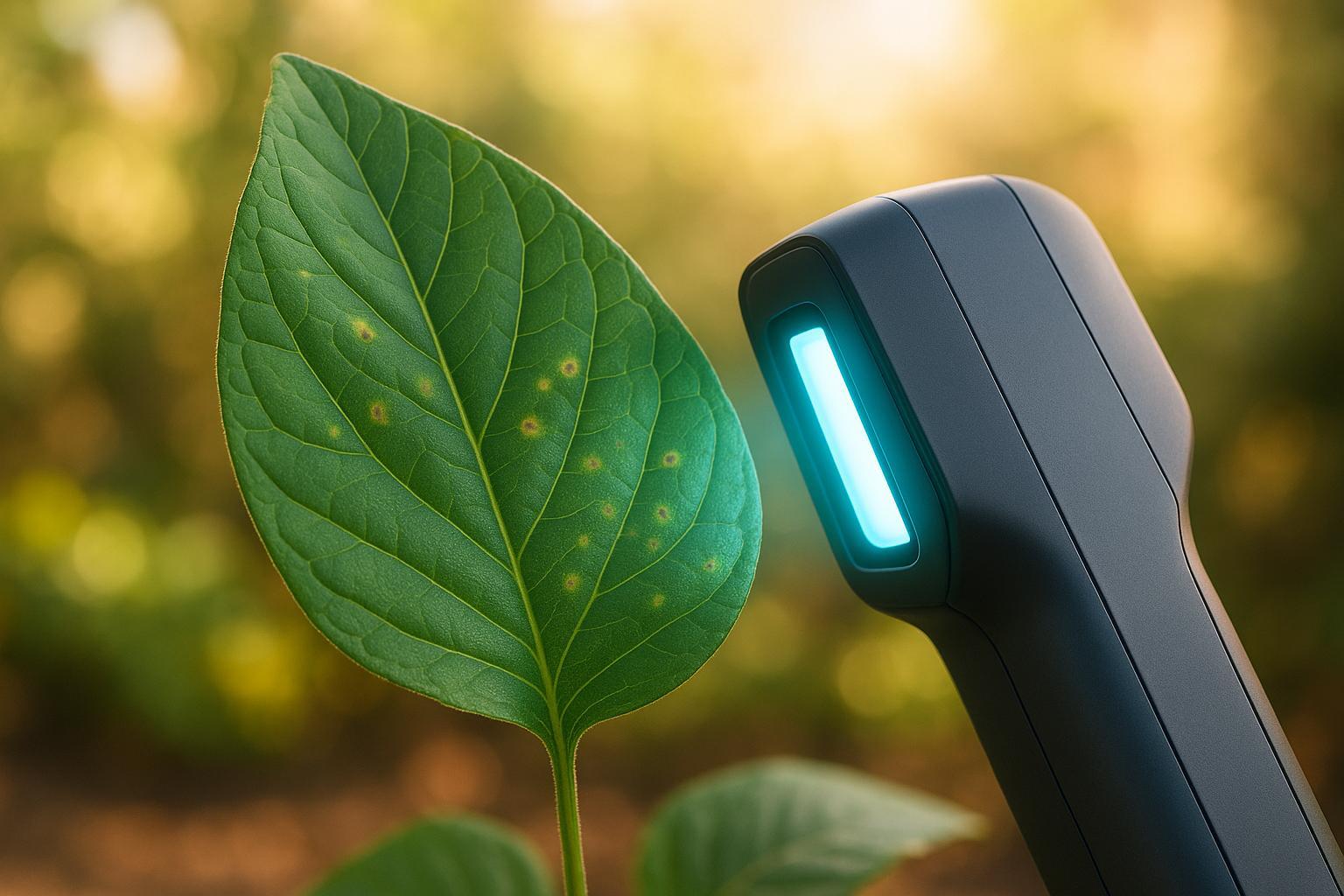
Optimizing Deep Learning for Plant Disease Detection
Explore how deep learning optimizes plant disease detection with advanced techniques for better accuracy, efficiency, and real-time monitoring.